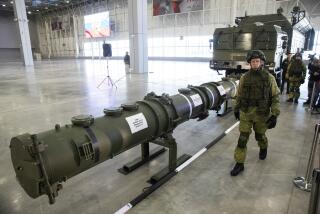Missile Treaty Could Weaken Europe’s Security, Aspin Warns
WASHINGTON — Rep. Les Aspin (D-Wis.), chairman of the powerful House Armed Services Committee, said Tuesday that it is vital to follow up an expected U.S.-Soviet arms agreement by improving the balance of conventional forces in Europe and restoring the ceiling on long-range strategic nuclear weapons.
Addressing an arms control meeting of the American Assn. for the Advancement of Science, Aspin expressed “considerable doubts” about the prospective agreement, which would eliminate intermediate-range nuclear missiles.
“Though this treaty may not break American nuclear linkage to Europe’s defense, it will certainly bend it,” he said.
Aspin complained that the agreement would increase pressure to negotiate reductions in short-range or tactical nuclear weapons, which he said would further decrease nuclear protection for Europe, in the face of the Soviet Union’s advantage in conventional forces there.
Instead of such negotiations, Aspin said, the Administration should restore a cap on long-range nuclear weapons. This would prevent the Soviets from circumventing the intermediate-range agreement by adding long-range weapons to its arsenal and aiming them at Europe. He urged the Administration to return to compliance with the 1979 strategic arms limitation treaty (SALT II) and then work quickly for a new agreement to reduce these weapons by 50%.
Aspin also proposed new negotiations to reduce the Soviet Bloc’s superiority in conventional forces, estimated at 2 to 1. To build up to Soviet levels, 10 more North Atlantic Treaty Organization divisions would be needed, he said, noting that it would cost $75 billion initially, plus $20 billion a year to maintain the new divisions.
Echoing an approach first espoused by Sen. Sam Nunn (D-Ga.), chairman of the Senate Armed Services Committee, Aspin said that the United States should attempt to negotiate a reduction in the Soviet offensive weapons that pose the greatest threat, such as tanks, where the Soviets have a 5 to 1 advantage.
Such proposals relating to the anticipated missile agreement have been discussed in detail within NATO. Also discussed has been a third response: modernizing short-range NATO nuclear weapons.
But Aspin dismissed the modernization plans as perhaps “not do-able politically” and inadequate to reassure Europeans of U.S. nuclear support.
More to Read
Sign up for Essential California
The most important California stories and recommendations in your inbox every morning.
You may occasionally receive promotional content from the Los Angeles Times.










